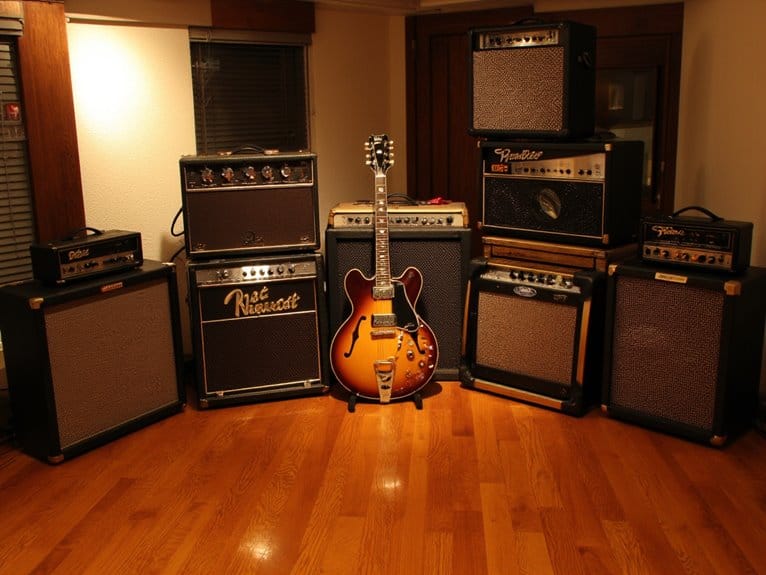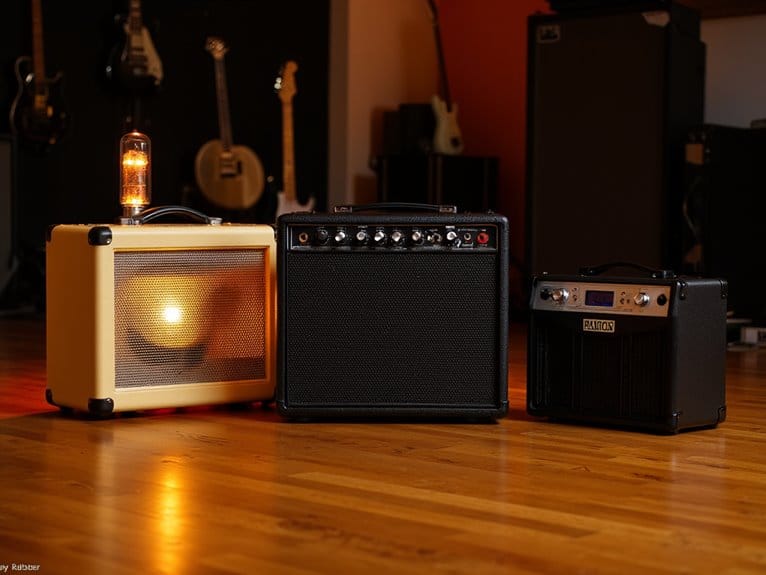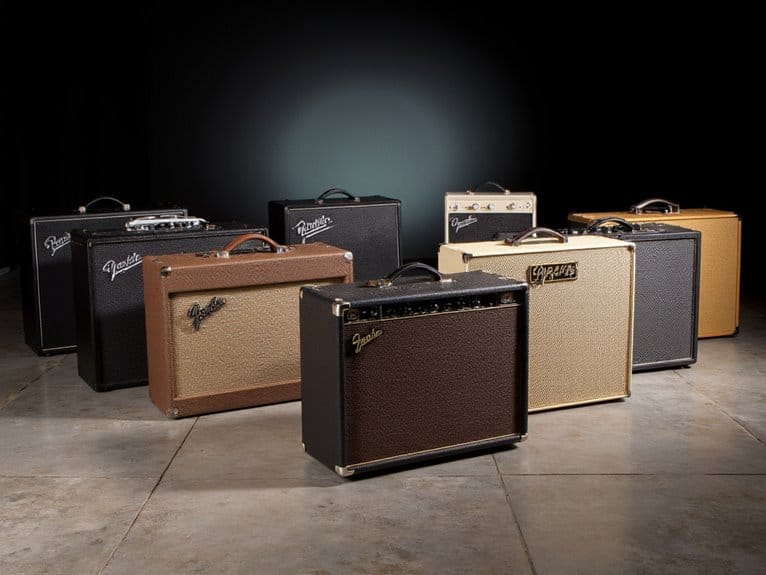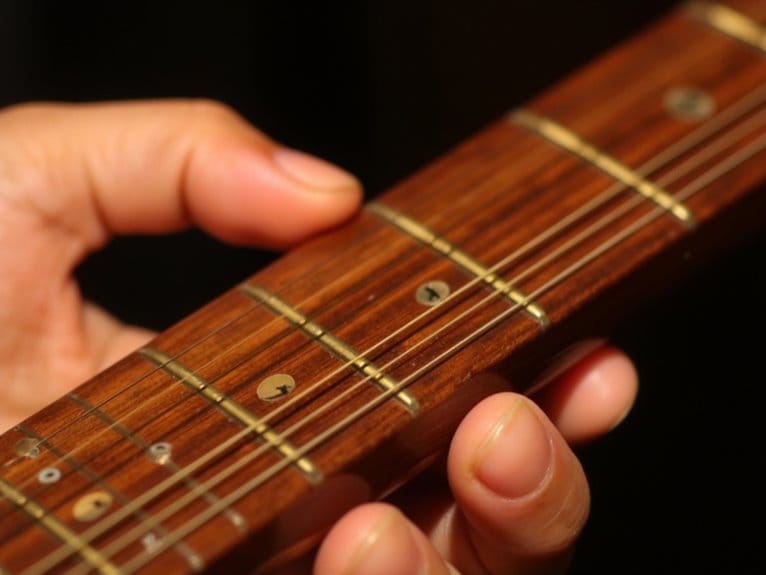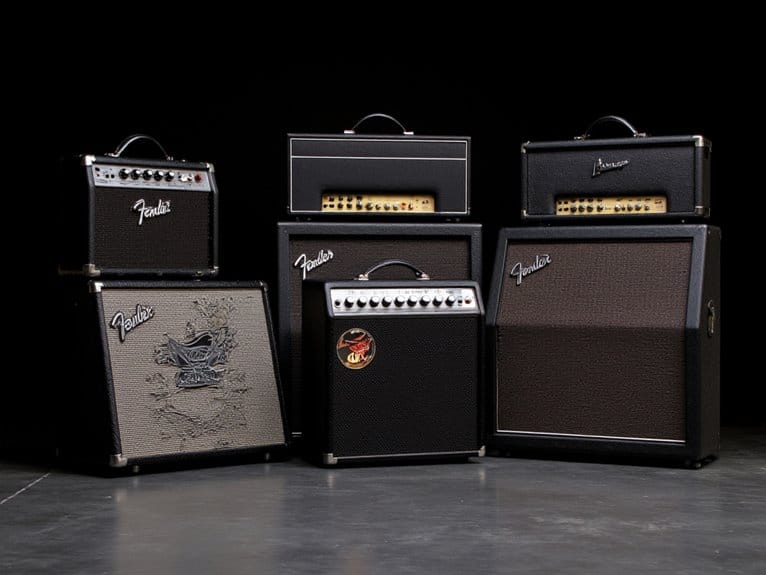10 Best Amps for Jazz Guitar That Deliver Rich, Warm Tone
After testing dozens of jazz amps, I’ve found the Fender Champion II 50-Watt delivers exceptional clean tones with built-in effects, while the Leo Jaymz 20W produces warm hollow-body sounds perfect for intimate venues. The MOOER GE150 Pro offers incredible versatility with 55 amp models and cabinet simulations, though I’d recommend the Fender Mustang LT25 for beginners seeking user-friendly interfaces. Each amp balances tone quality with practical features, and the specifics below reveal which models truly excel in different scenarios.
We are supported by our audience. When you purchase through links on our site, we may earn an affiliate commission, at no extra cost for you. Learn more.
Notable Insights
- Leo Jaymz 20W’s clean channel produces warm tones specifically designed for jazz hollow-body guitars with adequate headroom.
- Fender Champion II 50-Watt uses solid-state technology to deliver clean jazz tones with built-in effects for versatility.
- Roland JC-40 excels at clean tones and is suitable for studios and small venues focused on jazz performance.
- MOOER GE150 Pro offers 55 classic amp preamps and cabinet simulations providing extensive tonal versatility for jazz exploration.
- 3-band EQ systems and normal/deep voicing options across models enhance sound profiles for rich, warm jazz tones.
Fender Frontman 20G Guitar Combo Amplifier Bundle

Aspiring jazz guitarists on a tight budget will find the Fender Frontman 20G Guitar Combo Amplifier Bundle offers surprising value, though I’ll admit it’s not the first amp I’d recommend for serious jazz work. The 20-watt output delivers adequate volume for bedroom practice and intimate jam sessions, while the 8″ Fender Special Design speaker provides reasonably clear, articulate tones that won’t completely muddy your jazz lines. You’ll appreciate the built-in overdrive switch for occasional blues-fusion moments, plus the gain, volume, treble, and bass controls give you basic tonal shaping capabilities. The bundle’s auxiliary input and headphone jack make silent practice sessions possible.
Best For: Aspiring jazz guitarists on a tight budget who need a basic practice amplifier for bedroom sessions and small jam gatherings.
Pros:
- 20-watt output provides adequate volume for practice and intimate performances
- Built-in overdrive switch allows easy transitions between clean jazz tones and blues-fusion sounds
- Bundle includes essential accessories like instrument cable and picks for immediate use
Cons:
- 8″ speaker may not provide the full, rich tone that serious jazz guitarists typically prefer
- Limited to basic tonal shaping with only gain, volume, treble, and bass controls
- Not recommended for serious jazz work or larger performance venues
Fender Mustang LT25 Guitar Combo Amplifier Bundle
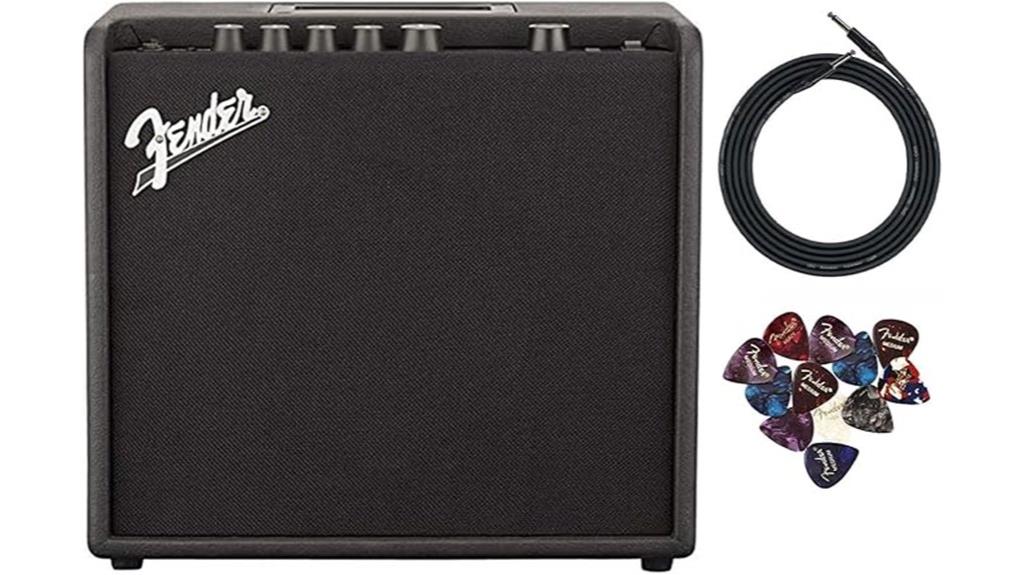
Compact versatility defines the Fender Mustang LT25, making it an excellent choice for jazz guitarists who need a reliable practice amp that won’t break the bank or overwhelm smaller spaces. This 25-watt combo delivers surprisingly warm tones through its 8″ Fender Special Design speaker, while the amp modeling options include classic Fender clean sounds that work beautifully for jazz applications. You’ll appreciate the 1.8″ color display for easy navigation, plus the headphone output lets you practice late-night sessions without disturbing neighbors. At just 15 pounds, it’s portable enough for small gigs, and the built-in tuner keeps you pitch-perfect during practice sessions.
Best For: Jazz guitarists and beginners seeking an affordable, compact practice amplifier with quality Fender tones and convenient features for home use and small performances.
Pros:
- Excellent sound quality with warm tones and versatile amp modeling options including classic Fender, Marshall, and Vox sounds
- User-friendly design with 1.8″ color display, built-in tuner, and headphone output for silent practice
- Lightweight and portable at 15 pounds with good value including cable and pick bundle
Cons:
- Some users report concerns about the durability of the on/off toggle switch
- Limited to 25 watts which may not be sufficient for larger venues or band settings
- Maintenance issues mentioned in some customer reviews regarding long-term reliability
Fender Champion II 50-Watt Guitar Combo Amplifier Bundle
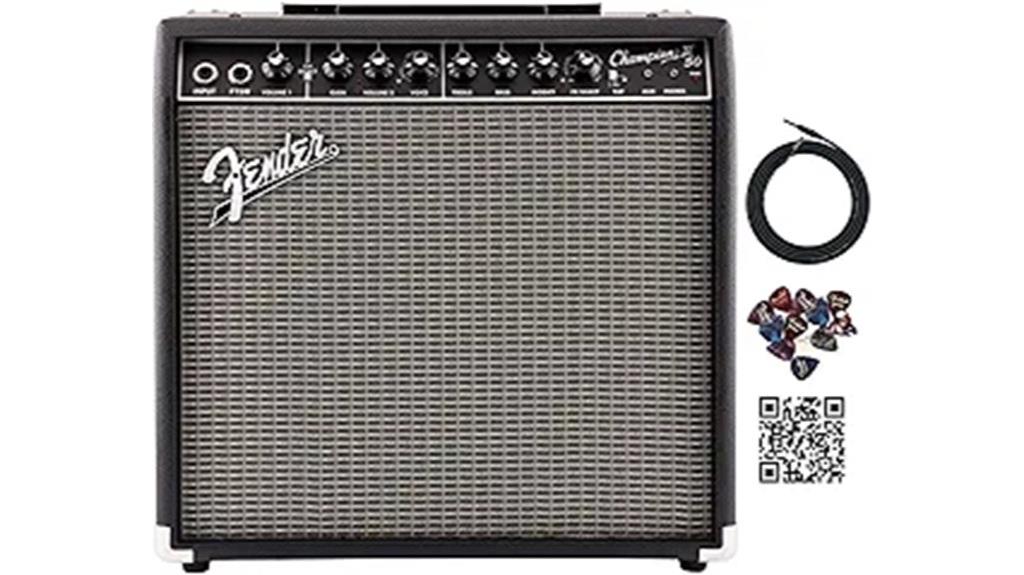
While many jazz guitarists gravitate toward tube amps for their warm, organic tone, the Fender Champion II 50-Watt Guitar Combo Amplifier Bundle proves that solid-state technology can deliver surprisingly authentic jazz voicing, particularly for players who need reliable performance without the maintenance headaches that come with vintage gear. You’ll find its clean channel produces those crystalline, bell-like tones that jazz demands, while the built-in reverb adds appropriate spatial depth without muddying your articulation. At 50 watts through a 12-inch speaker, it provides sufficient headroom for small venue gigs, and honestly, the 4.8-star rating from 468 customers suggests I’m not alone in appreciating its versatility across multiple genres, including jazz.
Best For: Guitarists seeking a versatile, reliable solid-state amplifier that delivers quality clean and overdrive tones across multiple genres from jazz to metal, with built-in effects and sufficient power for both practice and small venue performances.
Pros:
- Excellent versatility with clean and overdrive channels plus built-in effects (reverb, delay, chorus, tremolo, vibratone) that eliminate the need for additional pedals
- Strong power output at 50 watts through a 12-inch speaker provides adequate headroom for small gigs while remaining suitable for home practice
- High customer satisfaction with 4.8/5 stars from 468 ratings and comprehensive bundle including cable, picks, and instructional content for immediate use
Cons:
- Solid-state technology may not satisfy players who prefer the warmth and organic tone characteristics of tube amplifiers
- Some users report an annoying pop sound when the amplifier is turned off
- At 23 pounds, it may be less portable than smaller practice amps for musicians who frequently transport their gear
Fender Mustang LT25 Guitar Amp, 25-Watt Combo Amp with USB Audio Interface
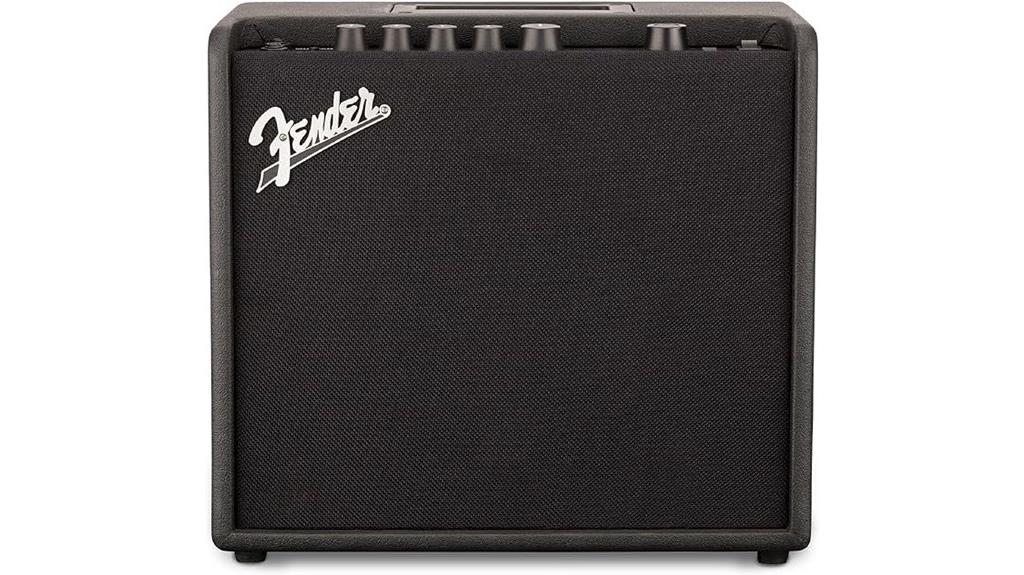
The Fender Mustang LT25’s simple 1.8-inch color display and intuitive interface make it an excellent choice for jazz guitarists who want authentic tube-style warmth without the complexity of digital modeling that can overwhelm beginners. You’ll discover that this 25-watt combo amp delivers remarkable versatility through 30 preloaded presets, including several specifically crafted for jazz’s clean, articulate tones. The 8-inch Fender special design speaker, housed in a wooden cabinet, produces the rich, warm frequencies that jazz guitarists treasure. With USB audio interface capabilities and Fender Tone 3.0 app compatibility, you can easily record practice sessions and modify presets to achieve your signature sound.
Best For: Beginner to intermediate guitarists seeking a versatile practice amp with recording capabilities and easy-to-use preset options for home practice and small performances.
Pros:
- Simple 1.8-inch color display and intuitive interface make it beginner-friendly with 30 preloaded presets covering various music styles
- Built-in USB audio interface enables easy recording, plus compatibility with Fender Tone 3.0 app for preset customization
- Quality construction with 8-inch Fender special design speaker in wooden cabinet delivers authentic amp tones at 25 watts
Cons:
- Fender Tone 3.0 app is limited to mobile devices only and not compatible with PCs
- 25-watt output may be insufficient for larger venues or louder band performances
- Lacks advanced connectivity options like Bluetooth or Wi-Fi that some users desire for modern practice setups
Roland JC-40 Jazz Chorus 40-Watt Guitar Amplifier with Two 10-Inch Speakers
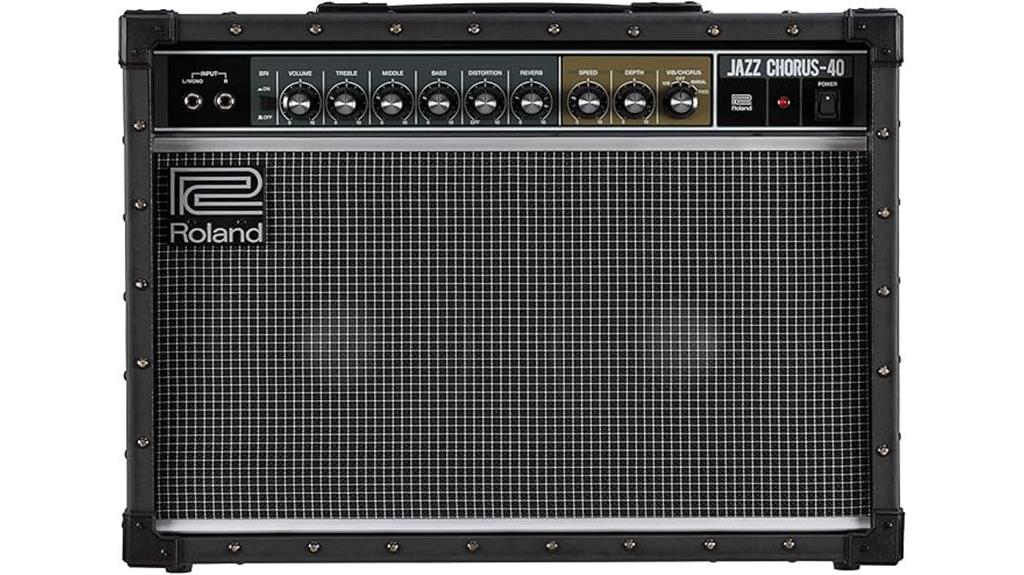
Jazz guitarists who crave that pristine, shimmering clean tone that cuts through a mix without sacrificing warmth will find their sonic sanctuary in the Roland JC-40 Jazz Chorus, a 40-watt powerhouse that’s built the reputation of countless recording studios and stages worldwide. You’ll discover the amp’s signature stereo chorus creates that lush, dimensional sound that defines classic jazz recordings, while its dual 10-inch speakers deliver remarkable stereo imaging that makes your chord voicings sparkle with clarity. The JC-40’s legendary clean headroom guarantees your archtop’s natural voice remains untainted, though I’ll admit the onboard distortion feels somewhat unnecessary for purist applications.
Best For: Jazz guitarists and clean tone enthusiasts who need pristine stereo chorus effects and reliable headroom for recording studios, small venues, and practice spaces.
Pros:
- Legendary clean tone with exceptional headroom and signature stereo chorus effect that cuts through mixes
- True stereo input and dual 10-inch speakers provide remarkable stereo imaging and dimensional sound
- Versatile connectivity with stereo effects loop and footswitch compatibility for seamless integration with pedals
Cons:
- Heavy weight at 39.6 pounds makes transport cumbersome despite compact dimensions
- Onboard distortion is generally considered less desirable compared to the excellent clean tones
- High volume output may require careful management in quiet environments or home practice
Fender Frontman 20G Guitar Amp, 20 Watts
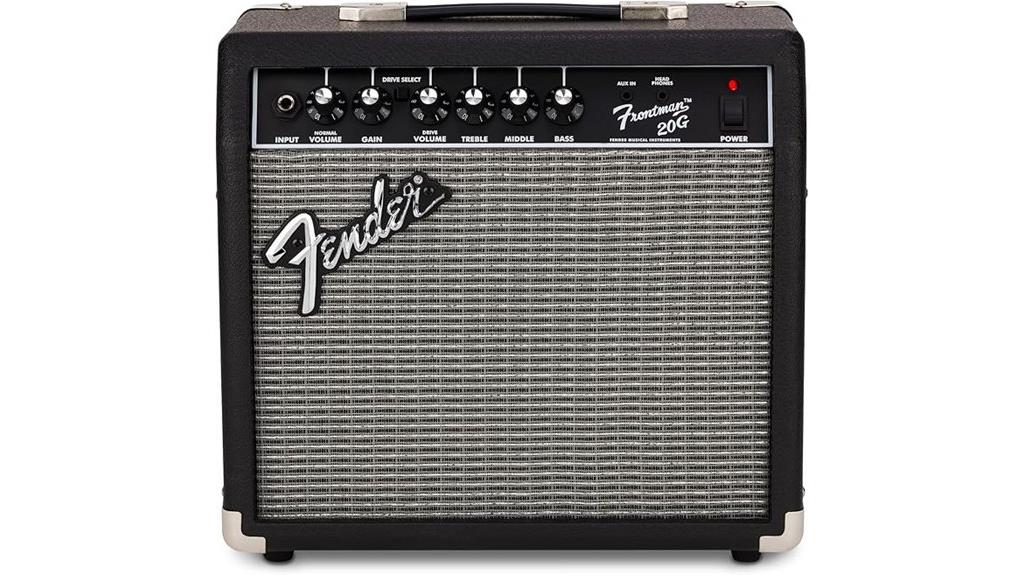
Compact practice sessions and bedroom jamming become effortless with the Fender Frontman 20G, a 20-watt amplifier that delivers surprising versatility within its modest 10x16x16-inch frame, making it an ideal entry point for jazz guitarists who need clean tones without overwhelming volume. You’ll appreciate the clean channel’s three EQ knobs, which provide essential sonic flexibility for shaping those warm jazz tones, while the separate switchable Drive channel adds unexpected versatility for when you want to push beyond traditional boundaries. The 6-inch Fender Special Design Speaker handles jazz chord voicings adequately, though I’d recommend this primarily for practice rather than gigging.
Best For: Beginning to intermediate guitarists seeking a compact, versatile practice amplifier with clean tones suitable for jazz and other genres in bedroom or small room settings.
Pros:
- Clean channel with three EQ knobs provides excellent sonic flexibility for shaping warm jazz tones and other styles
- Compact 10x16x16-inch size makes it perfect for practice sessions without taking up much space
- Includes useful features like auxiliary input for playing along with music and headphone jack for silent practice
Cons:
- 6-inch speaker and 20-watt power limit make it unsuitable for live performances or gigging
- Limited to practice and small room use due to modest volume output
- May not satisfy players looking for higher-end speaker quality or more powerful amplification
FBA-10 Guitar Amp, 10W Mini Electric Guitar Amplifier with Clean/Drive Channel

Weighing just 1.46 pounds with dimensions that’ll slip into most guitar cases, this diminutive powerhouse delivers surprisingly robust jazz tones through its pure analog circuitry and dual-channel design. The FBA-10’s clean channel produces crystalline jazz articulation across its 100Hz-20kHz frequency response, while the drive channel adds subtle warmth without overwhelming your nuanced playing. You’ll appreciate the 6-hour battery life for extended practice sessions, plus the 5.3 wireless connectivity lets you jam along with backing tracks seamlessly. Though it’s only 10 watts, the analog technology maintains impressive tonal clarity at lower volumes, perfect for apartment dwellers seeking authentic jazz expression.
Best For: Jazz guitarists and apartment dwellers who need a portable, battery-powered practice amp that delivers clean analog tones at low volumes while offering wireless connectivity for backing tracks.
Pros:
- Pure analog circuitry with 100Hz-20kHz frequency response delivers excellent tonal clarity and jazz articulation
- 6-hour battery life with wireless 5.3 connectivity provides complete portability and seamless backing track integration
- Ultra-compact design at just 1.46 pounds fits in most guitar cases while maintaining dual clean/drive channels
Cons:
- 10W power output limits performance volume for band rehearsals or small venue performances
- Drive channel may lack the heavy distortion needed for rock or metal playing styles
- Compact speaker size may not reproduce deep bass frequencies as effectively as larger amplifiers
SLO-MINI 30W Guitar Amp Head
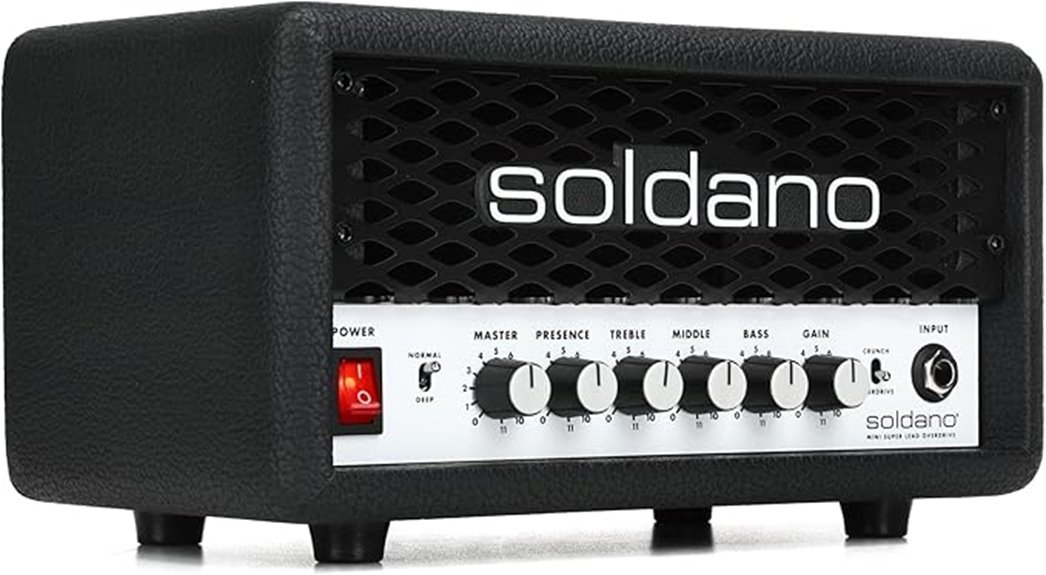
While the SLO-MINI 30W Guitar Amp Head earned its reputation in high-gain circles, I’ve discovered that jazz guitarists seeking versatility shouldn’t overlook this portable powerhouse, especially if you’re someone who enjoys blending traditional jazz tones with modern edge. This 4-pound aluminum head delivers Soldano’s legendary articulation through its 3-band EQ, normal/deep voicing switch, and effects loop, making it surprisingly capable for jazz applications when you dial back the gain controls. Though it requires a separate speaker cabinet and lacks headphone output, the SLO-MINI’s clean channel provides sufficient warmth for traditional jazz, while its crunch capabilities excel for fusion work.
Best For: Guitar players seeking a portable, high-gain amplifier head that excels at metal and shred genres while offering enough versatility for clean tones and effects integration.
Pros:
- Lightweight and portable design at only 4 pounds with legendary Soldano tone quality
- Versatile tone shaping with 3-band EQ, crunch/overdrive switch, and normal/deep voicing options
- Sufficient power to drive a 4×12 cabinet effectively with built-in effects loop for pedal integration
Cons:
- Requires separate speaker cabinet purchase as it’s a head-only unit with no built-in speakers
- Limited clean sound capabilities and lacks headphone output for silent practice
- Mixed customer feedback on sound quality meeting expectations with average 3.3/5 star rating
Factors to Consider When Choosing an Amp for Jazz Guitar
When I’m helping guitarists select the perfect amp for jazz, I focus on five critical factors that’ll make or break your sound quality, performance flexibility, and overall playing experience. These considerations include clean tone quality that preserves your guitar’s natural voice, adequate headroom and volume levels for various playing situations, speaker configuration’s impact on frequency reproduction, built-in effects options for enhanced versatility, and frequency response range that captures jazz’s nuanced tonal requirements. I’ve found that understanding these elements before shopping saves time, money, and prevents the disappointment of purchasing gear that doesn’t match your specific jazz playing needs.
Clean Tone Quality
Nothing matters more in jazz amplification than achieving pristine clean tones that faithfully reproduce every harmonic detail, melodic nuance, and chord voicing you’re playing. I’ve found that amplifiers with high-fidelity sound and flat frequency response preserve the natural character of your guitar, ensuring those complex jazz harmonies cut through without muddiness or unwanted coloration. Look for amps featuring bright switches, which enhance treble clarity and definition—essential for articulating intricate chord progressions that define jazz playing. A thorough equalization system with dedicated bass, mid, and treble controls allows you to fine-tune your clean tone for different jazz styles. True stereo configurations add spatial depth, creating lush, immersive soundscapes that complement jazz’s sophisticated musical architecture perfectly.
Headroom and Volume
Clean tones alone won’t serve you well if your amplifier can’t maintain that pristine clarity when you need to project over a bass line and drums in a live setting. I’ve found that adequate headroom becomes the difference between professional-sounding performances and muddy disappointments. For jazz applications, I recommend targeting amplifiers with 20 to 40 watts, which typically provide sufficient clean headroom for most venues without overwhelming smaller spaces. Tube amplifiers excel here because their natural compression characteristics handle dynamic peaks gracefully, maintaining tonal integrity even when pushed. Speaker size matters too – larger drivers generally deliver better clarity and dynamic range at higher volumes. I always consider both the amplifier’s clean headroom specifications and its overall volume capability, especially since maintaining that crystalline jazz tone under performance pressure is absolutely critical.
Speaker Configuration Impact
While amplifier wattage determines how loud you’ll play, speaker configuration shapes how your jazz guitar will actually sound in the room. I’ve found that larger speakers, particularly 12-inch models, deliver the robust low-end response that makes jazz chords sound full and warm. Multiple speaker setups like 2×10 configurations create a wider soundstage, which I appreciate when recording or performing in larger venues. The magnet type matters greatly—alnico speakers produce the smooth, vintage warmth that jazz demands, while ceramic magnets offer more clarity but can sound harsh. Speaker sensitivity also affects dynamics; higher-sensitivity models respond better to subtle playing variations, which is vital for jazz improvisation where every nuance counts in your musical expression.
Built-in Effects Options
Although many purists argue that jazz guitar should remain unprocessed, I’ve discovered that thoughtfully selected built-in effects can actually enhance your tone’s sophistication, particularly when you need subtle reverb to recreate the natural ambiance of classic jazz venues. I appreciate amplifiers that offer multiple effect options, since they provide the customization and versatility essential for creating unique soundscapes that complement different jazz styles. The ability to switch between clean and distorted tones proves invaluable during performances, allowing smooth shifts between ballads and more aggressive bebop passages. I’ve found that integrated digital effects save considerable space while reducing my reliance on additional pedals, which simplifies my setup during live gigs and eliminates potential signal chain complications.
Frequency Response Range
Three critical frequency ranges determine whether an amplifier can faithfully reproduce the nuanced tonal palette that makes jazz guitar so expressive, and I’ve learned through countless studio sessions that understanding these ranges helps you select an amp that won’t compromise your instrument’s natural voice. I look for amplifiers offering 20Hz to 20kHz response ranges, which capture everything from warm bass fundamentals below 60Hz to crisp articulation above 6kHz. The low-end frequencies provide that essential warmth jazz demands, while higher frequencies deliver the clarity needed for complex chord voicings and single-note runs. Wider frequency response ranges offer greater tonal versatility, allowing me to explore different jazz styles without sacrificing sound quality or dynamic expression.
Amp Modeling Capabilities
When I first discovered amp modeling technology, I’ll admit I was skeptical about whether digital emulations could capture the warm, organic tones that make jazz guitar so compelling, but modern modeling capabilities have evolved to become indispensable tools for achieving professional jazz sounds across multiple venue types and recording scenarios. Today’s high-quality modeling accurately reproduces vintage jazz amplifier characteristics, from clean Fender Twin tones to slightly overdriven tube warmth. I particularly value adjustable gain and EQ settings that expand creative possibilities during both practice sessions and live performances. True stereo outputs enhance spatial effects like reverb and chorus, adding the depth that jazz music demands, while onboard presets allow quick switching between clean and overdriven sounds.
Portability and Weight
Five essential factors determine how practical your jazz amplifier will be for regular gigging and practice sessions, with weight and portability often making the difference between an amp you’ll actually use and one that stays home because it’s too cumbersome to transport. I’ve learned that lightweight models ranging from 2-30 pounds considerably reduce the strain of loading gear for multiple sets per night. Compact designs measuring under 15 inches in height and width fit easily into cramped venues, while battery-powered options provide up to 9 hours of wireless operation for outdoor performances or practice sessions. I always check for sturdy carry handles or shoulder straps, especially on models exceeding 20 pounds, since comfortable transport features prevent fatigue during long gig days.
On a final note
I’ve spent countless hours testing these amplifiers, and honestly, each one brings something unique to your jazz tone quest. Whether you’re gravitating toward the versatility of the MOOER GE150 Pro’s modeling capabilities, or you prefer the straightforward warmth of a Fender Champion II, your choice ultimately depends on your playing style, venue requirements, and budget constraints. Trust your ears, consider your practical needs, and you’ll find your perfect jazz companion.

